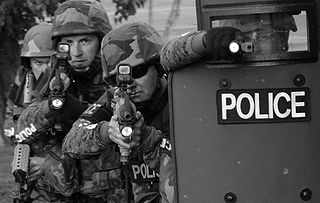How to Fund an American Police StateReal Money for an Imaginary WarBy Stephan Salisbury Mar. 06, 2012 |
Popular 
Claim Jewish Student Was 'Stabbed In The Eye' by Pro-Palestine Protester Draws Mockery After Video Released

Mistrial Declared in Case of Arizona Rancher Accused of Killing Migrant Trespasser

Sen. Hawley: Send National Guard to Crush Pro-Palestine Protests Like 'Eisenhower Sent the 101st to Little Rock'

Senate Passes $95B Giveaway to Israel, Ukraine, and Taiwan, Combined With TikTok Ban

AP: 'Israeli Strikes on Gaza City of Rafah Kill 22, Mostly Children, as U.S. Advances Aid Package'
  At the height of the Occupy Wall Street evictions, it seemed as though some diminutive version of “shock and awe” had stumbled from Baghdad, Iraq, to Oakland, California. American police forces had been “militarized,” many commentators worried, as though the firepower and callous tactics on display were anomalies, surprises bursting upon us from nowhere. At the height of the Occupy Wall Street evictions, it seemed as though some diminutive version of “shock and awe” had stumbled from Baghdad, Iraq, to Oakland, California. American police forces had been “militarized,” many commentators worried, as though the firepower and callous tactics on display were anomalies, surprises bursting upon us from nowhere. There should have been no surprise. Those flash grenades exploding in Oakland and the sound cannons on New York’s streets simply opened small windows onto a national policing landscape long in the process of militarization -- a bleak domestic no man’s land marked by tanks and drones, robot bomb detectors, grenade launchers, tasers, and most of all, interlinked video surveillance cameras and information databases growing quietly on unobtrusive server farms everywhere. The ubiquitous fantasy of “homeland security,” pushed hard by the federal government in the wake of 9/11, has been widely embraced by the public. It has also excited intense weapons- and techno-envy among police departments and municipalities vying for the latest in armor and spy equipment. In such a world, deadly gadgetry is just a grant request away, so why shouldn’t the 14,000 at-risk souls in Scottsbluff, Nebraska, have a closed-circuit-digital-camera-and-monitor system (cost: $180,000, courtesy of the Homeland Security Department) identical to the one up and running in New York’s Times Square? So much money has gone into armoring and arming local law-enforcement since 9/11 that the federal government could have rebuilt post-Katrina New Orleans five times over and had enough money left in the kitty to provide job training and housing for every one of the record 41,000-plus homeless people in New York City. It could have added in the growing population of 15,000 homeless in Philadelphia, my hometown, and still have had money to spare. Add disintegrating Detroit, Newark, and Camden to the list. Throw in some crumbling bridges and roads, too. But why drone on? We all know that addressing acute social and economic issues here in the homeland was the road not taken. Since 9/11, the Department of Homeland Security alone has doled out somewhere between $30 billion and $40 billion in direct grants to state and local law enforcement, as well as other first responders. At the same time, defense contractors have proven endlessly inventive in adapting sales pitches originally honed for the military on the battlefields of Iraq and Afghanistan to the desires of police on the streets of San Francisco and lower Manhattan. Oakland may not be Basra but (as former Secretary of Defense Donald Rumsfeld liked to say) there are always the unknown unknowns: best be prepared. All told, the federal government has appropriated about $635 billion, accounting for inflation, for homeland security-related activities and equipment since the 9/11 attacks. To conclude, though, that “the police” have become increasingly militarized casts too narrow a net. The truth is that virtually the entire apparatus of government has been mobilized and militarized right down to the university campus. Perhaps the pepper spray used on Occupy demonstrators last November at University of California-Davis wasn’t directly paid for by the federal government. But those who used it work closely with Homeland Security and the FBI “in developing prevention strategies that threaten campus life, property, and environments,” as UC Davis’s Comprehensive Emergency and Continuity Management Plan puts it. Government budgets at every level now include allocations aimed at fighting an ephemeral “War on Terror” in the United States. A vast surveillance and military buildup has taken place nationwide to conduct a pseudo-war against what can be imagined, not what we actually face. The costs of this effort, started by the Bush administration and promoted faithfully by the Obama administration, have been, and continue to be, virtually incalculable. In the process, public service and the public imagination have been weaponized. Read More |



